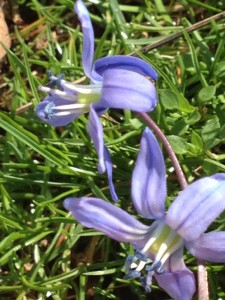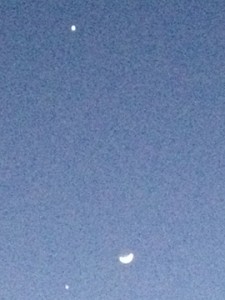Spring on the Maumee River had 2 escaped white farmyard ducks trying to join in the mating fun with their wild companions. We’ll watch out for dappled white ducklings.
Among the wild ducks one often sees one single female being wooed/saught by ten or more drakes, sometimes with much splashing. Where are the other 9?
The geese are all paired up – we never see the mating but some are obviously carrying eggs judging be the size of their tail ends. The male is more alert with head up and watching for problems like pesky photographers.

As soon as it was warm enough to fly, the bees climbed out of their winter cluster where they’d huddled for warmth. My project this year is to simply record, as best I can with a cell phone camera, each flower harvested by the bees.
Starting with the Snowdrop: I could confirm that one as it was the only flower open when the first bees were bringing in yellow pollen.
This is my best close-up yet showing Snowdrop pollen on the hind legs, just about to be brought into the hive. Unlike the regular camera which does not like to zoom in when in macro mode, this phone camera has no macro, but when fully zoomed, and using flash, it took this amazing detail from about 4 inches away. Very hard to focus properly.
Then this delightful blue Siberian Scilla or Squill (thanks to Jen & Scott for i.d.) flower gave some bees bright blue pollen. It should be used to feed baby bees and hopefully does not make blue honey.
The Pear tree was next to blossom:
Then Myrtle:
The bees like Myrtle but so does this impersonator who seems to have no stinger (I’ll check it if I can catch it) but looks enough like a bee for the predators to avoided it.
In the river the Walleye are running and many fisherfolk are standing in very cold water for long times:
 This man caught 3 but appears to have used 4 arms to do it:
This man caught 3 but appears to have used 4 arms to do it:
In the house, O’s Amaryllis finally decided to gloriously bloom after at least 2 years of false starts. I’m tempted to bring in a few bees for it, but Alice might not approve.
As the Equinox passed we had one clear sky at sunrise letting me catch another solar alignment. It will need a small picture placed on that sunny spot on the wall to see if it will light up again at the next Equinox on September 21st?
In the night sky last Sunday and Monday (3/25, 26) the Moon danced with Venus and Jupiter.
The Moon quickly shifted position as Venus and Jupiter slowly drift apart. (The lowest 6 lights in the right hand image are only from Maumee buildings)
One Final Observation:
The Exxon Valdez, which dumped so much crude oil on Alaskan shores years ago, was sold for scrap the other day. I had never realized she’d been sailing in the interim, under the most amazing name of “Oriental Nicety”. I don’t want to know under whose flag?
























